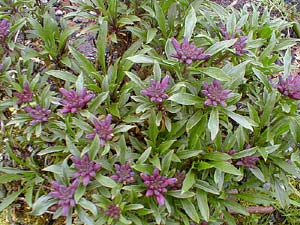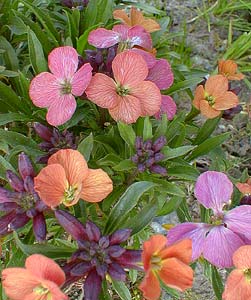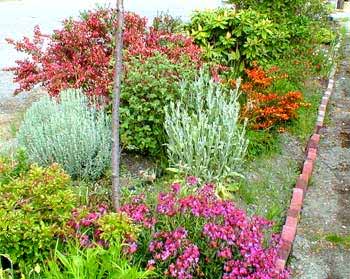
'Wenlock Beauty'
Alpine Wallflower
"The sundial has no time
to measure time;
Into the mouldering ground
it has sunk
As if wallflower perfume
has made it drunk."
-Wilhelm Lehmann
(1882-1968)
(1882-1968)
'Wenlock Beauty' is a multicolor-flowering cultivar of Erysimum linifolium (formerly Cheiranthus linifolium), commonly called Alpine Wallflower. "Wenlock" alludes to its habitat in an area of Great Britain inclusive of Shropshire.
 A recipient of the Award of Garden Merit, it is strikingly floral, with fragrant clusters on stubby stems. It forms a short bushy evergreen subshrub of generally less than a foot & a half height, slowly creeping into a wider & wider clump.
A recipient of the Award of Garden Merit, it is strikingly floral, with fragrant clusters on stubby stems. It forms a short bushy evergreen subshrub of generally less than a foot & a half height, slowly creeping into a wider & wider clump.It has smaller leaves than most Erysimums & keeps a pleasing presence through the winter.
In our zone it is covered with pinkish buds in early April (2003), as shown in the first photo. By April's end it begins blooming at first a few flowers at a time, then in May it blooms up a storm. The second May (2003) photo.
It is an excellent rockery plant, or useful as a creeping groundcover in a roadside sun-garden or along any sunny border. Ours is along a sidewalk in a low-maintence garden.
The third photo from May (2004) shows 'Wenlock Beauty' in one of the xeriscape gardens with other low-maintenance flowering shrubs & perennials.
 Simultaneously in bloom you can see two flowering scotch broom cultivars ('Lena' the smaller broom on the right, 'Burkwood's' the larger on the left); several other shrubs & peennials will be blooming as the days & weeks progress.
Simultaneously in bloom you can see two flowering scotch broom cultivars ('Lena' the smaller broom on the right, 'Burkwood's' the larger on the left); several other shrubs & peennials will be blooming as the days & weeks progress.The redolent four-petaled flowers open in clusters in extravagantly varied shades of rose, purple, pink, & lavender, fading toward the end of its bloom season to mauve, orange, or a coppery-hued dusky maroon. All these shades can be observed even on a single terminal cluster of mixed-color.
In general, it does well in full sun to partial shade, but here on the Northwest coast, full sun is just about required & it would languish in much if any shade.
If it has any drawbacks it is that it can be somewhat shortlived, tiring after a few years, but can be re-started from woody cuttings.